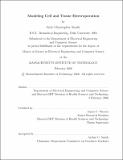| dc.contributor.advisor | James C. Weaver. | en_US |
| dc.contributor.author | Smith, Kyle Christopher | en_US |
| dc.contributor.other | Massachusetts Institute of Technology. Dept. of Electrical Engineering and Computer Science. | en_US |
| dc.date.accessioned | 2007-01-10T15:37:11Z | |
| dc.date.available | 2007-01-10T15:37:11Z | |
| dc.date.copyright | 2006 | en_US |
| dc.date.issued | 2006 | en_US |
| dc.identifier.uri | http://hdl.handle.net/1721.1/35301 | |
| dc.description | Thesis (S.M.)--Massachusetts Institute of Technology, Dept. of Electrical Engineering and Computer Science, 2006. | en_US |
| dc.description | This electronic version was submitted by the student author. The certified thesis is available in the Institute Archives and Special Collections. | en_US |
| dc.description | Includes bibliographical references (p. 201-213). | en_US |
| dc.description.abstract | Large, pulsed electric fields are becoming an increasingly important tool in drug delivery, gene delivery, and apoptosis induction. Nonetheless, much remains unknown about the fundamental mechanisms by which large electric fields interact with cells and tissue, in part because many critical features of the cell and tissue responses occur on time and length scales that are difficult to assess experimentally. Therefore, sophisticated models are needed to further understanding of the basic mechanisms of interaction. Electroporation, in which transient, aqueous pores form in lipid bilayers, is one fundamental mechanism by which large electric fields may alter biological systems. Here cell and tissue electroporation models are presented that are based on the asymptotic model of electroporation and the new mesh transport network method (MTNM), which utilizes equivalent circuit networks to simulate nonlinear, coupled transport phenomena. The cell system simulations show that small magnitude (0.1 MV/m), long duration (100 [mu]s) pulses result in conventional electroporation, in which pores form in only the plasma membrane, while large magnitude (10 MV/m), short duration (10 ns) pulses result in supra-electroporation, in which pores form in the plasma membrane and organelle membranes. | en_US |
| dc.description.abstract | (cont.) The organelle membrane electroporation may be a primary mechanism by which large magnitude, short duration pulses lead to complex, experimentally observed responses, including apoptosis. The tissue system simulations show that dynamic spatial shifts in the electric field accompany electroporation. For certain pulses, the shifting electric field can lead to quite spatially extensive tissue electroporation. The models presented here offer new insights into the dynamic electrical responses of cells and tissue to pulses of widely varying strength and duration and will contribute to the development of new therapies and biotechnologies based on electroporation. | en_US |
| dc.description.statementofresponsibility | by Kile Christopher Smith. | en_US |
| dc.format.extent | 213 p. | en_US |
| dc.format.extent | 16901930 bytes | |
| dc.format.extent | 16897618 bytes | |
| dc.format.mimetype | application/pdf | |
| dc.format.mimetype | application/pdf | |
| dc.language.iso | eng | en_US |
| dc.publisher | Massachusetts Institute of Technology | en_US |
| dc.rights | M.I.T. theses are protected by copyright. They may be viewed from this source for any purpose, but reproduction or distribution in any format is prohibited without written permission. See provided URL for inquiries about permission. | en_US |
| dc.rights.uri | http://dspace.mit.edu/handle/1721.1/7582 | |
| dc.subject | Electrical Engineering and Computer Science. | en_US |
| dc.title | Modeling cell and tissue electroporation | en_US |
| dc.type | Thesis | en_US |
| dc.description.degree | S.M. | en_US |
| dc.contributor.department | Massachusetts Institute of Technology. Department of Electrical Engineering and Computer Science | |
| dc.identifier.oclc | 75285530 | en_US |
